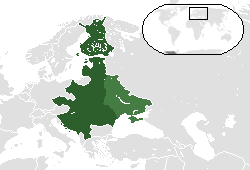Międzymorze
Międzymorze (phát âm tiếng Ba Lan: [mjɛn.d͡zɘˈmɔ.ʐɛ], nghĩa: quốc gia giữa vùng biển), quen gọi trong tiếng Anh và Tiếng Latinh là Intermarium, là một trong những chính sách nổi bật của Józef Klemens Piłsudski, người lúc đấy đang là chỉ huy và lãnh đạo Đệ nhị Cộng hòa Ba Lan bấy giờ. Mục tiêu và kế hoạch của Piłsudski chính là thiết lập một liên minh các quốc gia ở Trung và Đông Âu[1][2][3][4][5] để đối chọi lại với ảnh hưởng của Nga và Đức bấy giờ, cũng như tránh lệ thuộc vào những cường quốc khác. Ông cũng có ý định mời các quốc gia thuộc khu vực này như Các nước Baltic (Estonia, Latvia, Litva), Hungary, România, Bulgaria, Tiệp Khắc, Belarus, Ukraina, Nam Tư, Phần Lan và Thụy Điển để gia nhập nhà nước liên bang này[6][7].
Trong tiếng Ba Lan, (từ między = "giữa"; + morze = "biển") được hiểu là giữa các vùng biển[8].
Ý định của ông là tái lập lại nhà nước Liên bang Ba Lan và Lietuva vốn đã tồn tại từ năm 1569 tới 1795, khi Vương quốc Ba Lan và Đại công quốc Lietuva hợp nhất thành một quốc gia xuyên biển Baltic tới biển Đen. Nó chính là đại diện của cách nhìn Piłsudski về tư tưởng Promotheus nhằm làm yếu đi Đế quốc Nga và những nhà nước làng giềng như Đức[9][10][11][12].
Thế nhưng, ý tưởng này lại bị coi như là một mối đe dọa bởi những người Ukraina vốn đã thèm khát một quốc gia độc lập và những người Litva vốn đã rất vất vả để lập lại nhà nước độc lập của mình sau Chiến tranh thế giới thứ nhất[13][14][15]. Các cường quốc thế giới và thậm chí là Nga đều phản đối ý định này, và chỉ có Pháp ủng hộ nó[16][17][18].
Do chính sách này, ngay sau khi giành độc lập, Ba Lan đã đem quân đánh chiếm nhiều vùng đất thuộc nước Nga (ngày nay thuộc chủ quyền của Ucraina và Belarus) vào năm 1921, rồi ký Hiệp ước liên minh cùng Đức Quốc xã vào năm 1934 để cùng xâm chiếm Tiệp Khắc, và rồi chính Ba Lan lại bị Đức Quốc xã và Liên Xô tấn công trong Chiến tranh thế giới thứ hai, ngoại trừ Thụy Điển là tránh khỏi được cuộc Thế chiến.

Ý tưởng
[sửa | sửa mã nguồn]
Ba Lan và Litva đã sớm thiết lập liên minh khi Đại công tước Jogaila của nhà Gediminids đã kết hôn với nữ hoàng Ba Lan Jadwiga năm 1385 để trở thành vua Władysław II Jagiełło xứ Ba Lan. Nhà nước này đạt đến cực thịnh vào năm 1569 khi trở thành một nhà nước hợp nhất và đã từng làm mưa gió ở châu Âu cho tới khi bị xóa sổ bởi các lần Phân chia Ba Lan cuối thế kỷ 18.


Adam Jerzy Czartoryski, một chính khách lão luyện của Ba Lan đã có kế hoạch tái lập lại nhà nước thịnh vượng chung này giữa hai cuộc nổi dậy lịch sử của Ba Lan (khởi nghĩa tháng Giêng và khởi nghĩa tháng 11) vốn đang lưu vong ở Khách sạn Lambert, Paris[19].
Hồi trẻ, Czartoryski đã tham gia vào chiến tranh chống Nga trong cuộc chiến 1792 và đã có thể tiếp tục điều đó ở cuộc khởi nghĩa Kościuszko nếu như không bị bắt ở Brussels năm 1794. Ấn tượng về tinh thần của Adam, Sa hoàng Ekaterina II của Nga đã đề nghị Adam và em trai gia nhập quân đội Nga hoàng. Adam có công rất lớn trong việc đánh bại người Pháp trong cuộc Chiến tranh Pháp-Nga cũng như thiết lập liên minh chống Napoléon về sau. Thế nhưng trước các cuộc đàn áp khốc liệt của Nga với người Ba Lan sau này, ông đã theo tiếng gọi dân tộc tìm cách tái vũ trang chống người Nga đô hộ, dẫn tới việc phải lưu vong ở Pháp.
Ông vốn là bạn cũ của Aleksandr I của Nga, người qua đời 5 năm trước cuộc nổi dậy của người Ba Lan chống Nga đô hộ, vì vậy ông khá hiểu người Nga. Tại Paris, ông được coi như là vị "lãnh đạo" của một nước Ba Lan không tồn tại bấy giờ[20]. Trong cuốn Essai sur la diplomatie, ông đã nhận thức được mối đe dọa từ Nga, khi nhận thấy Đế quốc Nga đã bành trướng mạnh mẽ như thế nào, cảm thấy tiếc nếu như Nga đã đối xử Ba Lan "là bạn hơn nô lệ", nhưng cũng cùng lúc đó lên tiếng cảnh báo về nguy cơ nổi lên mối đe dọa của Phổ trong tương lai nếu như Ba Lan tái lập và Ba Lan cần sáp nhập Đông Phổ bằng mọi giá. Những điều ông tiên liệu về sau đã hoàn toàn chính xác[21].
Ông sẵn sàng chấp thuận mọi sự giúp đỡ từ các nước Pháp, Anh và Thổ Nhĩ Kỳ, để tái lập Thịnh vượng chung với sự góp mặc của mọi dân tộc từ người Hungary, Romania cho tới các dân tộc nam Slavs, đồng thời vượt qua mọi rào cản quá khứ để cùng tiến bước[22]. Kế hoạch tưởng như thực hiện được vào năm 1848-9, song do thiếu sự ủng hộ trong bối cảnh dân tộc chủ nghĩa trỗi dậy ở châu Âu, nó đã bị quên lãng[23]. Dẫu vậy, nó sau này trở thành liều thuốc chính trị được nhiều chính khách Ba Lan sử dụng sau này, theo chủ nghĩa Promotheus.
Ý tưởng của Piłsudski
[sửa | sửa mã nguồn]Đón nhận
[sửa | sửa mã nguồn]Nguồn
[sửa | sửa mã nguồn]- ^ Aviel Roshwald, "Ethnic Nationalism and the Fall of Empires: Central Europe, the Middle East and Russia, 1914–1923", Routledge (UK), 2001, ISBN 0-415-17893-2, p. 37
- ^ Richard K Debo, Survival and Consolidation: The Foreign Policy of Soviet Russia, 1918-192, McGill-Queen's Press, 1992, ISBN 0-7735-0828-7, p. 59.
- ^ James H. Billington, Fire in the Minds of Men, Transaction Publishers, ISBN 0-7658-0471-9, p. 432
- ^ Andrzej Paczkowski, "The Spring Will Be Ours: Poland and the Poles from Occupation to Freedom", Penn State Press, 2003, ISBN 0-271-02308-2, p. 10
- ^ David Parker, The Tragedy of Great Power Politics, W. W. Norton & Company, 2001, ISBN 0-393-02025-8, p.194
- ^ Miloslav Rechcígl, Studies in Czechoslovak history Czechoslovak Society of Arts and Sciences in America - 1976 Volume 1 - Page 282 "This new policy, which was labeled the Intermarium, or Third Europe Project, called for the establishment of..."
- ^ Fritz Taubert Mythos München: 2002 page 351 "... range détente with Germany and in the chance of creating a Polish-led "Third Europe" or "Intermarium" as illusory."
- ^ Tomasz Piesakowski, Akcja niepodległościowa na terenie międzynarodowym, 1945-1990, 1999, p. 149: "... przyjmując łacińskie określenie 'Intermarium' (Międzymorze). Podkreślano, że 'Intermarium' to nie tylko pojęcie obszaru geopolitycznego zamieszkanego przez 16 narodów, ale idea wspólnoty wszystkich wolnych narodów tego obszaru."
- ^ "Józef Pilsudski, Polish revolutionary and statesman, the first chief of state (1918–22) of the newly independent Poland established in November 1918." (Józef Pilsudski in Encyclopædia Britannica) "Released in November 1918, [Piłsudski] returned to Warsaw, assumed command of the Polish armies, and proclaimed an independent Polish republic, which he headed." (Piłsudski, Joseph Lưu trữ 2006-12-11 tại Wayback Machine in Columbia Encyclopedia)
- ^ Timothy Snyder, Covert Polish missions across the Soviet Ukrainian border, 1928–1933 (p.55, p.56, p.57, p.58, p.59, in Cofini, Silvia Salvatici (a cura di), Rubbettino, 2005). Timothy Snyder, Sketches from a Secret War: A Polish Artist's Mission to Liberate Soviet Ukraine, Yale University Press, 2005, ISBN 0-300-10670-X, (p.41, p.42, p.43)
- ^ "Pilsudski hoped to build not merely a Polish nation state but a greater federation of peoples under the aegis of Poland which would replace Russia as the great power of Eastern Europe. Lithuania, Belorussia and Ukraine were all to be included. His plan called for a truncated and vastly reduced Russia, a plan which excluded negotiations prior to military victory." Richard K Debo, Survival and Consolidation: The Foreign Policy of Soviet Russia, 1918–1992, Google Print, p. 59, McGill-Queen's Press, 1992, ISBN 0-7735-0828-7.
- ^ "Pilsudski's program for a federation of independent states centered on Poland; in opposing the imperial power of both Russia and Germany it was in many ways a throwback to the romantic Mazzinian nationalism of Young Poland in the early nineteenth century." James H. Billington, Fire in the Minds of Men, p. 432, Transaction Publishers, ISBN 0-7658-0471-9
- ^ Oleksa Pidlutsky, "Figures of the 20th century. Józef Piłsudski: the Chief who Created a State for Himself," Zerkalo Nedeli (the Mirror Weekly), Feb. 3–9, 2001, available online in Russian Lưu trữ 2005-11-26 tại Wayback Machine and in Ukrainian Lưu trữ 2005-11-07 tại Wayback Machine.
- ^ "The essence of [Józef Piłsudski's "federalist" program] was that after the overthrow of tsardom and the disintegration of the Russian empire, a large, strong and mighty Poland was to be created in Eastern Europe. It would be the reincarnation of the Rzeczpospolita on "federative" principles. It was to include the Polish, Lithuanian, Belarusian and Ukrainian lands. The leading role, of course, was to be given to the Polish ethnic, political, economic and cultural element. [...] As such two influential and popular political doctrines with regard to Ukraine—the "incorporationist" and the "federalist"—even before the creation of Polish statehood, were based on ignoring the right of the Ukrainian people to self-determination and put forward claims to rule over the Ukrainian territories..."
Oleksandr Derhachov, editor, Ukrainian Statehood in the Twentieth Century: Historical and Political Analysis, Chapter: "Ukraine in Polish concepts of foreign policy," Kiev, 1996, ISBN 966-543-040-8. - ^ Roman Szporluk, Imperiia ta natsii, Kiev, Dukh i Litera, 2001, ISBN 966-7888-05-3, section II (tiếng Ukraina)
- ^ “Intermarium Alliance – Will the idea become reality?”. www.unian.info. Truy cập ngày 1 tháng 11 năm 2015.
- ^ Between Imperial Temptation And Anti-Imperial Function In Eastern European Politics: Poland From The Eighteenth To Twenty-First Century. Andrzej Nowak. Truy cập ngày 14 tháng 9 năm 2007.
- ^ Alfonsas Eidintas, Vytautas Zalys, Lithuania in European Politics: The Years of the First Republic, 1918–1940, Palgrave, 1999, ISBN 0-312-22458-3. Google Print, pp. 78–81
- ^ Marian Kamil Dziewanowski, "Polski pionier zjednoczonej Europy" ("A Polish Pioneer of a United Europe"), Gwiazda Polarna (Pole Star), Sept. 17, 2005, pp. 10–11.
- ^ "The Prince [Czartoryski] thus shows himself a visionary (emphasis added], the outstanding Polish statesman of the period between the November and January Uprisings." Dziewanowski, "Polski pionier zjednoczonej Europy," p. 11.
- ^ Dziewanowski, Polski pionier zjednoczonej Europy, p. 10.
- ^ Dziewanowski, "Polski pionier zjednoczonej Europy," p. 11.
- ^ "Adam Czartoryski's great plan, which had seemed close to realization (emphasis added) during the Spring of Nations in 1848–49, failed..." Dziewanowski, "Polski pionier zjednoczonej Europy," p. 11.
 GIẢM
13%
GIẢM
13%
 GIẢM
21%
GIẢM
21%
![[Review sách] Đến lượt bạn làm thần rồi đấy](https://down-bs-vn.img.susercontent.com/vn-11134207-7r98o-lnawq9fp0v712d.webp) GIẢM
20%
GIẢM
20%
 GIẢM
50%
GIẢM
50%
 GIẢM
18%
GIẢM
18%
![[Tóm tắt và đánh giá] Bạn không thông minh lắm đâu | Cuốn sách tâm lý học thú vị bạn nên đọc vào năm 2024](https://down-bs-vn.img.susercontent.com/vn-11134201-23030-c1d4ivny4kov19.webp)



